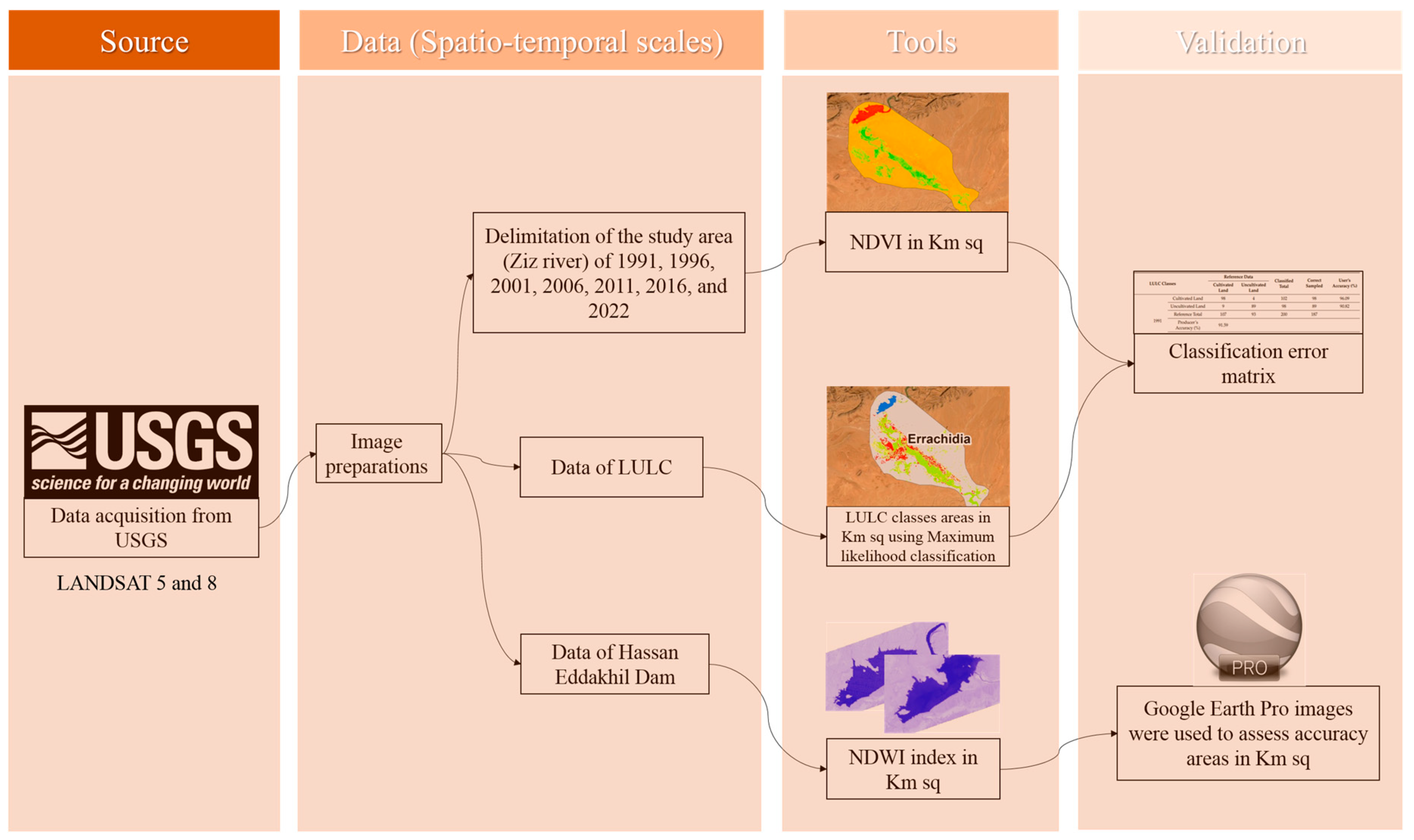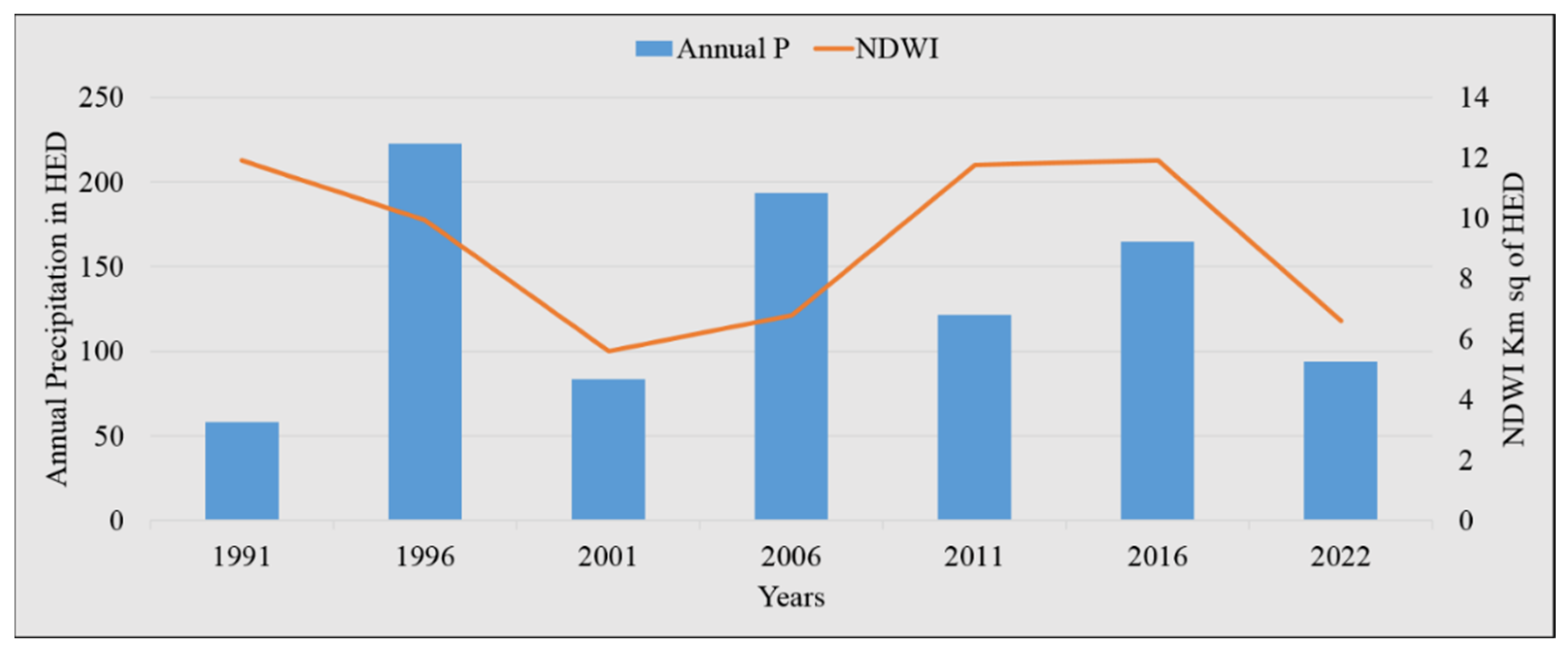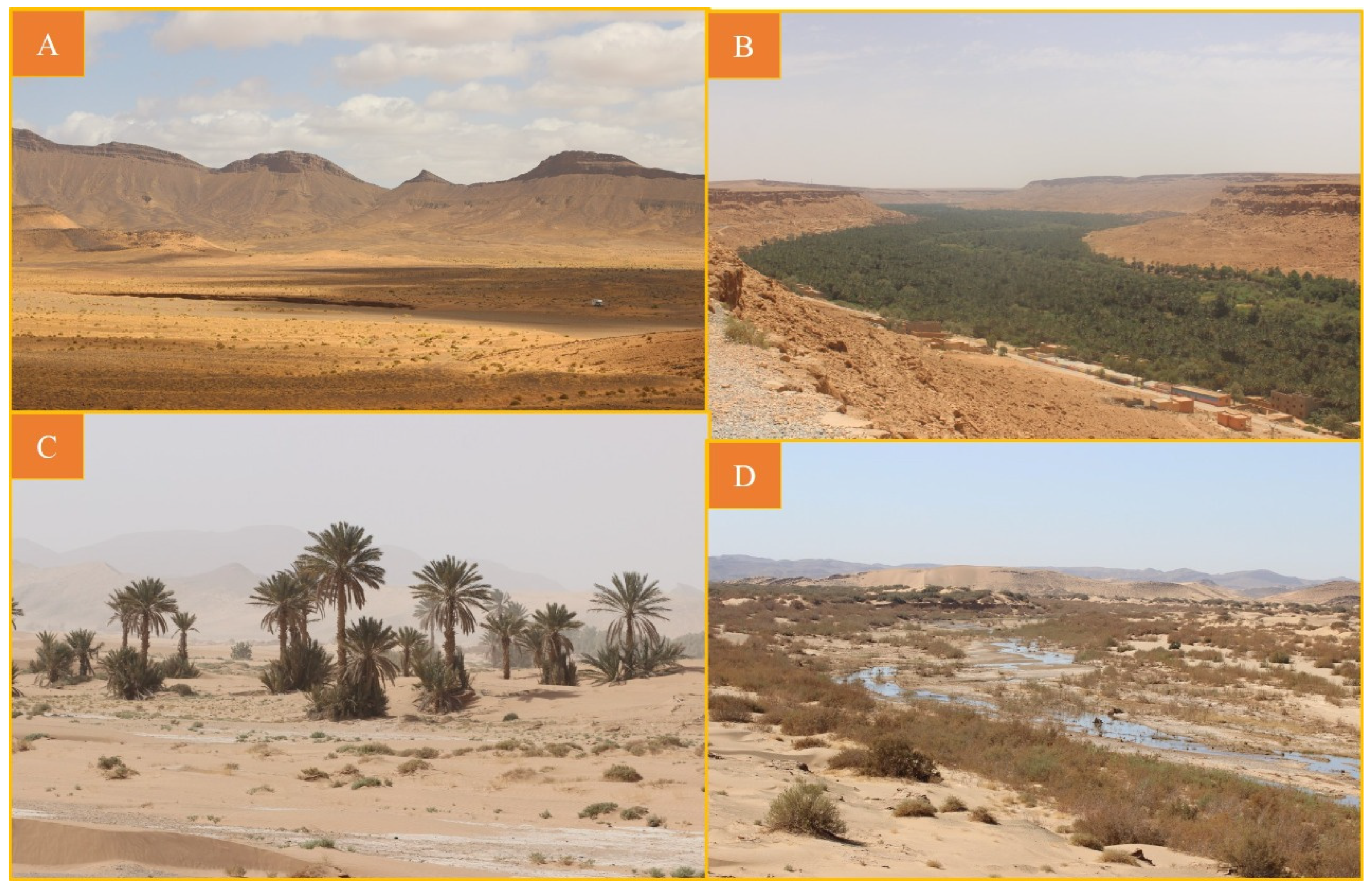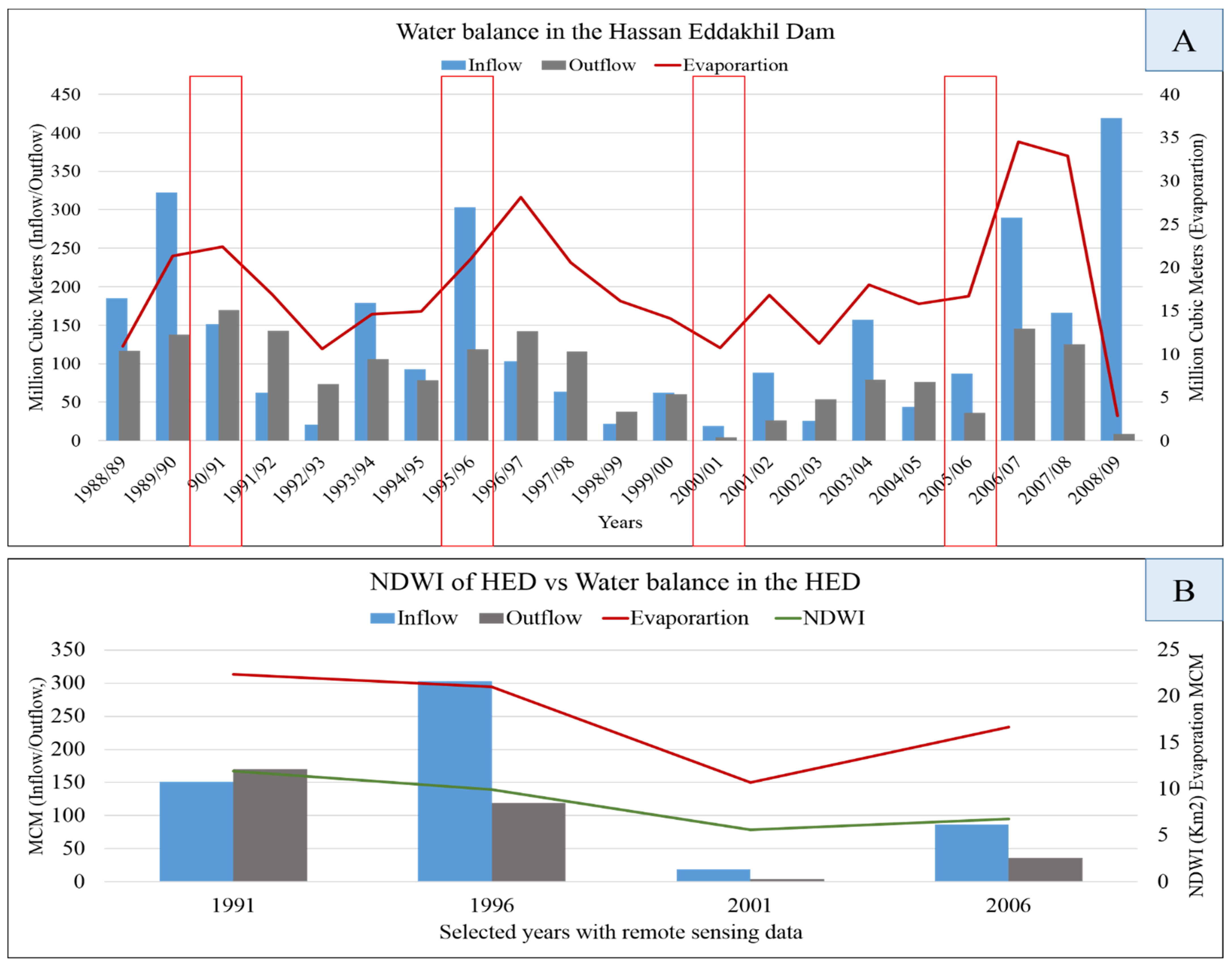Thirty Years of Change in the Land Use and Land Cover of the Ziz Oases (Pre-Sahara of Morocco) Combining Remote Sensing, GIS, and Field Observations
Abstract
:1. Introduction
2. Materials and Methods
2.1. Study Area
- Climatically, by low rainfall inputs that do not compensate the significant evaporation and frequent and drying winds with very high sunshine;
- Hydrologically, the water balance is largely in deficit;
- Socioeconomically, oases are intensively cultivated agro-ecosystems and are considered favorable settlements and stopover of desert forwarders throughout history.
2.2. Methodology
2.2.1. Satellite Data Preparation
2.2.2. The Maximum Likelihood Classification (MCL)
2.2.3. The Vegetation Index
2.2.4. Water Index
2.2.5. Classification Accuracy
2.2.6. Associations between LULC and Surface Water in the Dam
2.2.7. Urban Area Change
2.2.8. Ancillary Data
2.2.9. Geographic and Statistical Analyses
3. Results
3.1. LULC Classes Using NDVI
3.2. Accuracy Assessment for the Classified Images
3.3. NDWI of Hassan Eddakhil Dam
3.4. Maximum Likelihood Classification 1991 and 2022
4. Discussion
- The intervention of the National Institute of Agronomic Research to preserve the genetic material of national patrimony;
- Selection of new varieties;
- Distribution of over 1.5 million of in vitro plants since 1987 to reconstitute the oases.
- Recognize the oases and their exceptional fragile nature;
- Implement effective measures to conserve the oases heritage including livelihood and biodiversity;
- Value the economic potentialities of these ecosystems.
Limitations of the Study
5. Conclusions
Author Contributions
Funding
Informed Consent Statement
Data Availability Statement
Acknowledgments
Conflicts of Interest
Abbreviations
| CC | Climate Change |
| HED | Hassan Eddakhil Dam |
| GIS | Geographic Information System |
| LULC | Land use and Land Cover |
| MLC | Maximum Likelihood Classification |
| NDBI | Normalized Difference Built-up Index |
| NDVI | Normalized Difference Vegetation Index |
| NDWI | Normalized Difference Water Index |
| RS | Remote Sensing |
| SDGs | Sustainable Development Goals |
References
- El-Saied, A.B.; El-Ghamry, A.; Khafagi, O.M.A.; Powell, O.; Bedair, R. Floristic diversity and vegetation analysis of Siwa Oasis: An ancient agro-ecosystem in Egypt’s Western Desert. Ann. Agric. Sci. 2015, 60, 361–372. [Google Scholar] [CrossRef]
- Huang, F.; Ochoa, C.G. A copula incorporated cellular automata module for modeling the spatial distribution of oasis recovered by ecological water diversion: An application to the Qingtu Oasis in Shiyang River basin, China. J. Hydrol. 2022, 608, 127573. [Google Scholar] [CrossRef]
- Yin, X.; Feng, Q.; Li, Y.; Deo, R.C.; Liu, W.; Zhu, M.; Zheng, X.; Liu, R. An interplay of soil salinization and groundwater degradation threatening coexistence of oasis-desert ecosystems. Sci. Total Environ. 2022, 806, 150599. [Google Scholar] [CrossRef]
- Moumane, A.; El Ghazali, F.E.; Al Karkouri, J.; Delorme, J.; Batchi, M.; Chafiki, D.; Karmaoui, A. Monitoring spatiotemporal variation of groundwater level and salinity under land use change using integrated field measurements, GIS, geostatistical, and remote-sensing approach: Case study of the Feija aquifer, Middle Draa watershed, Moroccan Sahara. Environ. Monit. Assess. 2021, 193, 769. [Google Scholar] [CrossRef] [PubMed]
- Hamamouche, M.F.; Kuper, M.; Amichi, H.; Lejars, C.; Ghodbani, T. New reading of Saharan agricultural transformation: Continuities of ancient oases and their extensions (Algeria). World Dev. 2018, 107, 210–223. [Google Scholar] [CrossRef]
- Haj-Amor, Z.; Acharjee, T.K.; Dhaouadi, L.; Bouri, S. Impacts of climate change on irrigation water requirement of date palms under future salinity trend in coastal aquifer of Tunisian oasis. Agric. Water Manag. 2020, 228, 105843. [Google Scholar] [CrossRef]
- Patzelt, A. The Fog Oasis in Southern Arabia–A Fragile Desert Cloud Forest Ecosystem at the Brink of Extinction. Ref. Modul. Earth Syst. Environ. Sci. 2021, 303–317. [Google Scholar] [CrossRef]
- El-Sheikh, M.A.; Al-Oteiby, S.A.; Alfarhan, A.H.; Barcelo, D.; Picó, Y.; Alatar, A.A.; Javed, S.B.; Eid, E.M. Distribution of soil organic carbon in Wadi Al-Thulaima, Saudi Arabia: A hyper-arid habitat altered by wastewater reuse. Catena 2018, 170, 266–271. [Google Scholar] [CrossRef]
- Moumane, A.; Al Karkouri, J.; Benmansour, A.; El Ghazali, F.E.; Fico, J.; Karmaoui, A.; Batchi, M. Monitoring long-term land use, land cover change, and desertification in the Ternata oasis, Middle Draa Valley, Morocco. Remote Sens. Appl. Soc. Environ. 2022, 26, 100745. [Google Scholar] [CrossRef]
- Karmaoui, A.; El Jaafari, S.; Chaachouay, H.; Hajji, L. The socio-ecological system of the pre-Sahara zone of Morocco: A conceptual framework to analyse the impact of drought and desertification. GeoJournal 2021, 87, 4961–4974. [Google Scholar] [CrossRef]
- Karmaoui, A. Drought and desertification in Moroccan Pre-Sahara, Draa valleys: Exploring from the perspective of young people. Geoenviron. Disasters 2019, 6, 1–13. [Google Scholar] [CrossRef]
- Diekkrüger, B.; Busche, H.; Klose, A.; Klose, S.; Rademacher, C.; Schulz, O. Impact of global change on hydrology and soil degradation—scenario analysis for the semi-arid Drâa catchment (South Morocco). River Basins Chang. 2012, 21–26. Available online: https://www.researchgate.net/publication/316989058_Impact_of_Global_Change_on_hydrology_and_soil_degradation_-_Scenario_analysis_for_the_semi-arid_Draa_catchment_South_Morocco (accessed on 21 June 2022).
- Wang, F.; Lai, H.; Li, Y.; Feng, K.; Zhang, Z.; Tian, Q.; Zhu, X.; Yang, H. Identifying the status of groundwater drought from a GRACE mascon model perspective across China during 2003–2018. Agric. Water Manag. 2022, 260, 107251. [Google Scholar] [CrossRef]
- Karmaoui, A.; El Qorchi, F.; Hajji, L.; Zerouali, S. Eco-epidemiological aspects of Zoonotic cutaneous leishmaniasis in Ouarzazate Province, Morocco. J. Parasit. Dis. 2021, 45, 341–350. [Google Scholar] [CrossRef]
- Ougougdal, H.A.; Khebiza, M.Y.; Messouli, M.; Bounoua, L.; Karmaoui, A. Delineation of vulnerable areas to water erosion in a mountain region using SDR-InVEST model: A case study of the Ourika watershed, Morocco. Sci. Afr. 2020, 10, e00646. [Google Scholar] [CrossRef]
- Ben Salem, S.; Ben Salem, A.; Karmaoui, A.; Khebiza Yacoubi, M.; Messouli, M. Quantification and Evaluation of Water Erosion: Application of the Model SDR—InVEST in the Ziz Basin in South-East Morocco. In Decision Support Methods for Assessing Flood Risk and Vulnerability; IGI Global: Hershey, PA, USA, 2019. [Google Scholar] [CrossRef]
- Noorisameleh, Z.; Khaledi, S.; Shakiba, A.; Firouzabadi, P.Z.; Gough, W.A.; Mirza, M.M.Q. Comparative evaluation of impacts of climate change and droughts on river flow vulnerability in Iran. Water Sci. Eng. 2020, 13, 265–274. [Google Scholar] [CrossRef]
- HCP. Monographie de la province d’Errachidia. High Commission for Planning. Direction Regionale de Draa-Tafilalet. Roy. Du Maroc 2019, 101, 23. Available online: https://www.hcp.ma/draa-tafilalet/Monographie-de-la-province-d-Errachidia-de-l-annee-2019_a269.html (accessed on 21 June 2022).
- Puy, A.; Herzog, M.; Escriche, P.; Marouche, A.; Oubana, Y.; Bubenzer, O. Detection of sand encroachment patterns in desert oases. The case of Erg Chebbi (Morocco). Sci. Total Environ. 2018, 642, 241–249. [Google Scholar] [CrossRef]
- Karmaoui, A.; Balica, S. A new flood vulnerability index adapted for the pre-Saharan region. Int. J. River Basin Manag. 2021, 19, 93–107. [Google Scholar] [CrossRef]
- Bahaj, T.; Kacimi, I.; Hilali, M.; Kassou, N.; Mahboub, A. Preliminary study of the groundwater geochemistry in the sub-desert area in Morocco: Case of the Ziz-Ghris basins. Procedia Earth Planet. Sci. 2013, 7, 44–48. [Google Scholar] [CrossRef]
- National Agency for Oases and Argan Tree Zones Development (ANDZOA). Available online: http://andzoa.ma/fr/presentation/ (accessed on 6 June 2022).
- Nouayti, N.; Khattach, D.; Hilali, M. Potential areas mapping for the groundwater storage in the high Ziz basin (Morocco): Contribution of remote sensing and geographic information system Cartographie des zones potentielles pour le stockage des eaux souterraines dans le haut bassin du Ziz (Maroc): Apport de la télédétection et du système d’information géographique. Bull. De L’institut Sci. Sect. Sci. De La Terre 2017, 39, 13. [Google Scholar]
- Baki, S.; Hilali, M.; Kacimi, I.; Kassou, N.; Nouiyti, N.; Bahassi, A. Assessment of groundwater intrinsic vulnerability to pollution in the Pre-Saharan areas-the case of the Tafilalet Plain (Southeast Morocco). Procedia Earth Planet. Sci. 2017, 17, 590–593. [Google Scholar] [CrossRef]
- Otukei, J.R.; Blaschke, T. Land cover change assessment using decision trees, support vector machines and maximum likelihood classification algorithms. Int. J. Appl. Earth Obs. Geoinf. 2010, 12, S27–S31. [Google Scholar] [CrossRef]
- Erdem, F.; Atun, R.; Avdan, Z.Y.; Atila, I.; Avdan, U. Drought analysis of Van Lake Basin with remote sensing and GIS technologies. Egypt. J. Remote Sens. Space Sci. 2021, 24, 1093–1102. [Google Scholar] [CrossRef]
- Ajaj, Q.M.; Pradhan, B.; Noori, A.M.; Jebur, M.N. Spatial monitoring of desertification extent in western Iraq using Landsat images and GIS. Land Degrad. Dev. 2017, 28, 2418–2431. [Google Scholar] [CrossRef]
- Twisa, S.; Buchroithner, M.F. Land-use and land-cover (LULC) change detection in Wami River Basin, Tanzania. Land 2019, 8, 136. [Google Scholar] [CrossRef]
- Gupta, V.D.; Areendran, G.; Raj, K.; Ghosh, S.; Dutta, S.; Sahana, M. Assessing habitat suitability of leopards (Panthera pardus) in unprotected scrublands of Bera, Rajasthan, India. In Forest Resources Resilience and Conflicts; Elsevier: Amsterdam, The Netherlands, 2021; pp. 329–342. [Google Scholar] [CrossRef]
- Xie, F.; Fan, H. Deriving drought indices from MODIS vegetation indices (NDVI/EVI) and Land Surface Temperature (LST): Is data reconstruction necessary? Int. J. Appl. Earth Obs. Geoinf. 2021, 101, 102352. [Google Scholar] [CrossRef]
- Shrestha, R.; Di, L.; Yu, G.; Shao, Y.; Kang, L.; Zhang, B. Detection of flood and its impact on crops using NDVI-Corn case. In Proceedings of the 2013 Second International Conference on Agro-Geoinformatics (Agro-Geoinformatics) 2013, Fairfax, VA, USA, 12–16 August 2013; pp. 200–204. [Google Scholar]
- Reszka, P.; Fuentes, A. The great Valparaiso fire and fire safety management in Chile. Fire Technol. 2015, 51, 753–758. [Google Scholar] [CrossRef]
- Gao, B.C. Normalized difference water index for remote sensing of vegetation liquid water from space. In Imaging Spectrometry; SPIE: Bellingham, WA, USA, 1995; Volume 2480, pp. 225–236. [Google Scholar] [CrossRef]
- Alsaady, W.F.; Mohammed, R. Detecting of climatic drought by combination geo-information system and remote sensing in semi-arid zones: A case study. Mater. Today Proc. 2021. [Google Scholar] [CrossRef]
- Rwanga, S.S.; Ndambuki, J.M. Accuracy assessment of land use/land cover classification using remote sensing and GIS. Int. J. Geosci. 2017, 8, 611. [Google Scholar] [CrossRef]
- Stehman, S.V.; Czaplewski, R.L. Design and analysis of thematic map accuracy assessment: Fundamental principles. Remote Sens. Environ 1998, 64, 331–344. [Google Scholar] [CrossRef]
- Costa, H.; Foody, G.M.; Boyd, D.S. Supervised methods of image segmentation accuracy assessment in land cover mapping. Remote Sens. Environ. 2018, 205, 338–351. [Google Scholar] [CrossRef]
- Lillesand, T.M.; Kiefer, R.W.; Chipman, J.W. Remote Sensing and Image Interpretation, 7th ed.; John Wiley & Sons, Inc.: Hoboken, NJ, USA, 2015. [Google Scholar]
- Congalton, R.G.; Oderwald, R.G.; Mead, R.A. Assessing Landsat classification accuracy using discrete multivariate analysis statistical techniques. Photogramm. Eng. Remote Sens. 1983, 49, 1671–1678. [Google Scholar]
- Rosenfield, G.H.; Fitzpatrick-Lins, K. A coefficientof agreement as a measure of thematic classification accuracy. Photogramm. Eng. Remote Sens. 1986, 52, 223–227. [Google Scholar]
- As-Syakur, A.; Adnyana, I.; Arthana, I.W.; Nuarsa, I.W. Enhanced built-up and bareness index (EBBI) for mapping built-up and bare land in an urban area. Remote Sens. 2012, 4, 2957–2970. [Google Scholar] [CrossRef]
- Zha, Y.; Gao, J.; Ni, S. Use of normalized difference built-up index in automatically mapping urban areas from TM imagery. Int. J. Remote Sens. 2003, 24, 583–594. [Google Scholar] [CrossRef]
- Zhao, H.; Chen, X. Use of normalized difference bareness index in quickly mapping bare areas from TM/ETM+. In Proceedings of the International Geoscience and Remote Sensing Symposium, Seoul, Republic of Korea, 25–29 July 2005; Volume 3, p. 1666. [Google Scholar]
- Rasul, A.; Balzter, H.; Ibrahim, G.R.; Hameed, H.M.; Wheeler, J.; Adamu, B.; Ibrahim, S.A.; Najmaddin, P.M. Applying built-up and bare-soil indices from Landsat 8 to cities in dry climates. Land 2018, 7, 81. [Google Scholar] [CrossRef]
- Anderson, J.R.; Hardy, E.E.; Roach, J.T.; Witmer, R.E. A Land Use and Land Cover Classification System for Use with Remote Sensor Data; USGS Numbered Series No. 964; USGS: Reston, VA, USA, 1976; Volume 964. [CrossRef]
- Foody, G.M. Status of land cover classification accuracy assessment. Remote Sens. Environ. 2002, 80, 185–201. [Google Scholar] [CrossRef]
- Wang, T.; Wang, Z.; Guo, L.; Zhang, J.; Li, W.; He, H.; Zong, R.; Wang, D.; Jia, Z.; Wen, Y. Experiences and challenges of agricultural development in an artificial oasis: A review. Agric. Syst. 2021, 193, 103220. [Google Scholar] [CrossRef]
- ANDZOA. Sustainable Oases Initiative. National Agency for Oases and Argan tree Zones Development; 2016, 22p. Available online: http://andzoa.ma/wp-content/uploads/2017/04/English_10042017.pdf (accessed on 21 June 2022).
- Zemni, N.; Slama, F.; Bouksila, F.; Bouhlila, R. Simulating and monitoring water flow, salinity distribution and yield production under buried diffuser irrigation for date palm tree in Saharan Jemna oasis (North Africa). Agric. Ecosyst. Environ. 2022, 325, 107772. [Google Scholar] [CrossRef]
- Zhou, Y.; Liao, W.; Li, X. The contributions of individual factors to the oasis cold island effect intensity in the Heihe River Basin. Agric. For. Meteorol. 2022, 312, 108706. [Google Scholar] [CrossRef]
- Peng, M.; He, H.; Wang, Z.; Li, G.; Lv, X.; Pu, X.; Zhuang, L. Responses and comprehensive evaluation of growth characteristics of ephemeral plants in the desert–oasis ecotone to soil types. J. Environ. Manag. 2022, 316, 115288. [Google Scholar] [CrossRef] [PubMed]
- Karmaoui, A.; Minucci, G.; Messouli, M.; Khebiza, M.Y.; Ifaadassan, I.; Babqiqi, A. Climate Change Impacts on Water Supply System of the Middle Draa Valley in South Morocco. In Climate Change, Food Security and Natural Resource Management; Behnassi, M., Pollmann, O., Gupta, H., Eds.; Springer: Cham, Switzerland, 2019. [Google Scholar] [CrossRef]
- Rafik, A.; Ibouh, H.; El Alaoui El Fels, A.; Eddahby, L.; Mezzane, D.; Bousfoul, M.; Amazirh, A.; Ouhamdouch, S.; Bahir, M.; Gourfi, A.; et al. Soil Salinity Detection and Mapping in an Environment under Water Stress between 1984 and 2018 (Case of the Largest Oasis in Africa-Morocco). Remote Sens. 2022, 14, 1606. [Google Scholar] [CrossRef]
- Sedra, M.H. Date Palm Status and Perspective in Morocco. In Date Palm Genetic Resources and Utilization; Al-Khayri, J., Jain, S., Johnson, D., Eds.; Springer: Dordrecht, The Netherlands, 2015; pp. 257–323. [Google Scholar] [CrossRef]
- Bouhlassa, S.; Paré, S. Évapotranspiration de référence dans la région aride de Tafilalet au sud-est du Maroc. Afr. J. Environ. Assess. Manag. 2006, 11, 1–16. Available online: https://www.researchgate.net/publication/230735080 (accessed on 21 June 2022).
- El Ouali, A.; El Hafyani, M.; Roubil, A.; Lahrach, A.; Essahlaoui, A.; Hamid, F.E.; Muzirafuti, A.; Paraforos, D.S.; Lanza, S.; Randazzo, G. Modeling and Spatiotemporal Mapping of Water Quality through Remote Sensing Techniques: A Case Study of the Hassan Addakhil Dam. Appl. Sci. 2021, 11, 9297. [Google Scholar] [CrossRef]
- Hssaisoune, M.; Bouchaou, L.; Sifeddine, A.; Bouimetarhan, I.; Chehbouni, A. Moroccan groundwater resources and evolution with global climate changes. Geosciences 2020, 10, 81. [Google Scholar] [CrossRef]
- Messouli, M.; Ben Salem, A.; Ghallabi, B.; Yacoubi-Khebiza, M.; Ait Boughrous, A.; El Alami El Filali, A.; Rochdane, S.; Ezzahra Hammadi, F. Ecohydrology and groundwater resources management under global change: A pilot study in the pre-Saharan basins of southern Morocco. Options Méditerranéennes 2009, 88, 255–264. [Google Scholar]
- de Haas, H.; Bencherifa, A.; de Haan, L.; El Ghanjou, H.; El Harradji, A.; Moumni, Y.; Sghaier, M.; Solé-Benet, A. Migration, Agricultural Transformations and Natural Resource Exploitation in the Oases of Morocco and Tunisia; Final Scientific Report, IMARROM Project 2001, IC18-CT97–0134 (EC, DGXII, INCO-DC); University of Amsterdam: Amsterdam, The Netherlands, 2001. [Google Scholar]
- Song, J.H.; Her, Y.; Kang, M.S. Estimating Reservoir Inflow and Outflow From Water Level Observations Using Expert Knowledge: Dealing With an Ill-Posed Water Balance Equation in Reservoir Management. Water Resour. Res. 2022, 58, e2020WR028183. [Google Scholar] [CrossRef]
- Karmaoui, A.; Ben Salem, A.; El Jaafari, S.; Chaachouay, H.; Moumane, A.; Hajji, L. Exploring the land use and land cover change in the period 2005–2020 in the province of Errachidia, the pre-sahara of Morocco. Front. Earth Sci. 2022, 10. [Google Scholar] [CrossRef]
- Anjarne, M.; Bougerfaoui, M.; Abahmane, L. Micropropagation of date palm: A tool for development of Moroccan palm groves devestated by Bayoud disease. In Actes du Symposium International sur le Développement Durable des Systèmes Oasiens du 08 au 10 Mars 2005 Erfoud, Maroc-B; Boulanouar, Kradi, C., Eds.; Available online: https://www.inra.org.ma/sites/default/files/publications/ouvrages/oasis.pdf (accessed on 21 June 2022).
- MDMEMEE. 3e RAPPORT, Communication Nationale du Maroc à la Convention Cadre des Nations Unies sur les Changements Climatiques. Ministère Délégué auprès du Ministre de l’Energie, des Mines, de l’Eau et de l’Environnement Chargé de l’Environnement. ROYAUME DU MAROC. Avril 2016. Available online: https://unfccc.int/resource/docs/natc/marnc3.pdf (accessed on 21 June 2022).
- Assembly, G. Resolution Adopted by the General Assembly on 11 September 2015; A/RES/69/315 15 September 2015; United Nations: New York, NY, USA, 2015; Available online: https://www.un.org/en/development/desa/population/migration/generalassembly/docs/globalcompact/A_RES_70_1_E.pdf (accessed on 21 June 2022).











| Satellite | Acquisition Date | Sensor | Number of Bands | Spatial Resolution | Path/Raw | Doi |
|---|---|---|---|---|---|---|
| (m) | ||||||
| LANDSAT 5 | 8 March 1991 | TM | 7 | 30 | 200/038 | https://doi.org/10.5066/P918ROHC, accessed on 7 April 2022 |
| LANDSAT 5 | 18 Feruary 1996 | TM | 7 | 30 | 200/038 | https://doi.org/10.5066/P918ROHC, accessed on 15 April 2022 |
| LANDSAT 5 | 15 Feruary 2001 | TM | 7 | 30 | 200/038 | https://doi.org/10.5066/P918ROHC, accessed on 15 April 2022 |
| LANDSAT 5 | 13 Feruary 2006 | TM | 7 | 30 | 200/038 | https://doi.org/10.5066/P918ROHC, accessed on 15 April 2022 |
| LANDSAT 5 | 31 March 2011 | TM | 7 | 30 | 200/038 | https://doi.org/10.5066/P918ROHC, accessed on 7 April 2022 |
| LANDSAT 8 | 28 March 2016 | OLI | 11 | 30 | 200/038 | https://doi.org/10.5066/P9OGBGM6, accessed on 15 April 2022 |
| LANDSAT 8 | 29 March 2022 | OLI | 11 | 30 | 200/038 | https://doi.org/10.5066/P9OGBGM6, accessed on 14 April 2022 |
| 1991 | 1996 | 2001 | 2006 | 2011 | 2016 | 2022 | |
|---|---|---|---|---|---|---|---|
| Cultivated | 174.26 | 145.86 | 59.94 | 56.12 | 135.91 | 158.11 | 82.26 |
| Uncultivated | 747.63 | 776.0 | 861.96 | 865.78 | 785.98 | 763.67 | 839.62 |
| Total | 921.89 | 921.87 | 921.91 | 921.90 | 921.9 | 921.78 | 921.88 |
| LULC Classes | Reference Data | Classified Total | Correct Sampled | User’s Accuracy (%) | |||
|---|---|---|---|---|---|---|---|
| Cultivated Land | Uncultivated Land | ||||||
| Classified data | 1991 | Cultivated Land | 98 | 4 | 102 | 98 | 96.09 |
| Uncultivated Land | 9 | 89 | 98 | 89 | 90.82 | ||
| Reference Total | 107 | 93 | 200 | 187 | |||
| Producer’s Accuracy (%) | 91.59 | ||||||
| Overall Accuracy = 93.5 | |||||||
| Kappa = 0.87 | |||||||
| 2001 | Cultivated Land | 90 | 5 | 95 | 90 | 94.74 | |
| Uncultivated Land | 13 | 92 | 105 | 92 | 87.62 | ||
| Reference Total | 103 | 97 | 200 | 182 | |||
| Producer’s Accuracy (%) | 87.38 | 94.86 | |||||
| Overall Accuracy = 91 | |||||||
| Kappa = 0.82 | |||||||
| 2011 | Cultivated Land | 95 | 3 | 98 | 95 | 96.94 | |
| Uncultivated Land | 21 | 81 | 102 | 81 | 79.41 | ||
| Reference Total | 116 | 84 | 200 | 176 | |||
| Producer’s Accuracy (%) | 81.9 | 96.43 | |||||
| Overall Accuracy = 88 | |||||||
| Kappa = 0.76 | |||||||
| 2022 | Cultivated Land | 88 | 1 | 89 | 88 | 98.88 | |
| Uncultivated Land | 17 | 94 | 111 | 94 | 84.69 | ||
| Reference Total | 105 | 95 | 200 | 182 | |||
| Producer’s Accuracy (%) | 83.81 | 98.95 | |||||
| Overall Accuracy = 91 | |||||||
| Kappa = 0.82 | |||||||
| LULC Classes | Reference Data | Classified Total | Correct Sampled | User’s Accuracy (%) | ||||||
|---|---|---|---|---|---|---|---|---|---|---|
| Cultivated Land | Desertified Land | Bare Land | Water | Built Up | ||||||
| Classified data | 1991 | Cultivated Area | 34 | 4 | 0 | 0 | 0 | 38 | 34 | 89.47 |
| Desertified Land | 0 | 18 | 13 | 0 | 1 | 32 | 18 | 56.25 | ||
| Bare Land | 0 | 12 | 76 | 0 | 0 | 88 | 76 | 86.36 | ||
| Water | 0 | 0 | 0 | 10 | 0 | 10 | 10 | 100 | ||
| Built-Up | 0 | 0 | 9 | 0 | 23 | 32 | 23 | 71.87 | ||
| Reference Total | 34 | 34 | 98 | 10 | 24 | 200 | 161 | |||
| Producer’s Accuracy (%) | 100 | 52.94 | 77.55 | 100 | 95.83 | |||||
| Overall Accuracy = 80.5 | ||||||||||
| Kappa Coefficient = 0.72 | ||||||||||
| 2022 | Cultivated Area | 98 | 7 | 0 | 0 | 0 | 105 | 98 | 93.33 | |
| Desertified Land | 0 | 27 | 7 | 0 | 2 | 36 | 27 | 75 | ||
| Bare Land | 0 | 9 | 30 | 0 | 0 | 39 | 30 | 76.92 | ||
| Water | 0 | 0 | 0 | 6 | 0 | 6 | 6 | 100 | ||
| Built-Up | 0 | 0 | 4 | 0 | 10 | 14 | 10 | 71.43 | ||
| Reference Total | 98 | 43 | 41 | 6 | 12 | 200 | 171 | |||
| Producer’s Accuracy | 100 | 62.79 | 73.17 | 100 | 83.33 | |||||
| Overall Accuracy = 85.5 | ||||||||||
| Kappa Coefficient = 0.78 | ||||||||||
| Years with Available Google Earth (GE) Images | Google Earth (GE) Approximation in | NDWI Estimations in | NDWI/GE (%) |
|---|---|---|---|
| 2016 | 13 | 11.91 | 91 |
| 2022 | 7.2 | 6.599 | 94 |
Disclaimer/Publisher’s Note: The statements, opinions and data contained in all publications are solely those of the individual author(s) and contributor(s) and not of MDPI and/or the editor(s). MDPI and/or the editor(s) disclaim responsibility for any injury to people or property resulting from any ideas, methods, instructions or products referred to in the content. |
© 2023 by the authors. Licensee MDPI, Basel, Switzerland. This article is an open access article distributed under the terms and conditions of the Creative Commons Attribution (CC BY) license (https://creativecommons.org/licenses/by/4.0/).
Share and Cite
Karmaoui, A.; Moumane, A.; El Jaafari, S.; Menouni, A.; Al Karkouri, J.; Yacoubi, M.; Hajji, L. Thirty Years of Change in the Land Use and Land Cover of the Ziz Oases (Pre-Sahara of Morocco) Combining Remote Sensing, GIS, and Field Observations. Land 2023, 12, 2127. https://doi.org/10.3390/land12122127
Karmaoui A, Moumane A, El Jaafari S, Menouni A, Al Karkouri J, Yacoubi M, Hajji L. Thirty Years of Change in the Land Use and Land Cover of the Ziz Oases (Pre-Sahara of Morocco) Combining Remote Sensing, GIS, and Field Observations. Land. 2023; 12(12):2127. https://doi.org/10.3390/land12122127
Chicago/Turabian StyleKarmaoui, Ahmed, Adil Moumane, Samir El Jaafari, Aziza Menouni, Jamal Al Karkouri, Mohammed Yacoubi, and Lhoussain Hajji. 2023. "Thirty Years of Change in the Land Use and Land Cover of the Ziz Oases (Pre-Sahara of Morocco) Combining Remote Sensing, GIS, and Field Observations" Land 12, no. 12: 2127. https://doi.org/10.3390/land12122127
APA StyleKarmaoui, A., Moumane, A., El Jaafari, S., Menouni, A., Al Karkouri, J., Yacoubi, M., & Hajji, L. (2023). Thirty Years of Change in the Land Use and Land Cover of the Ziz Oases (Pre-Sahara of Morocco) Combining Remote Sensing, GIS, and Field Observations. Land, 12(12), 2127. https://doi.org/10.3390/land12122127








